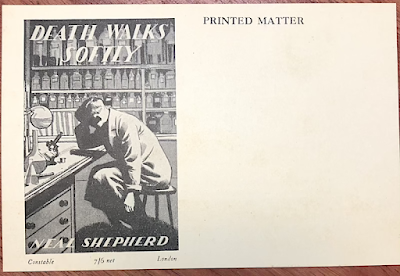
Here’s a list for you. Tell me if you know what they all have in common.
- Heart to Heart by Boileau-Narcejac
- Withered Murder by Anthony & Peter Shaffer
- The Midnight Mystery by Bertram Atkey
- Three Dead Men by Paul McGuire
- Thirteen Stannergate by G. M. Wilson
- Murder on the Day of Judgment by Virginia Rath
- Stranger on the Highway by H. R. Hays
Pretty easy, I’d say. All of them are fantastic crime novels that still have not been reprinted and the original editions are difficult to impossible to find now. Plus, all of them are books I’ve written about on this blog praising them and often dropping hints in the final paragraph to publishers that here is a title they ought to reissue. In some cases like G.M. Wilson and Boileau-Narcejac every single book ought to be reprinted. These are the books, I believe, readers would like to see back in print. The gems that have been languishing in Out-of-Printdom (some for over eighty years) and copies of the original editions are disappearing from the face of the planet. Literally! It’s very frustrating to me to see books that readers have been longing for, books that seriously cannot be found anywhere, being passed over for others that are getting their second, third and fourth lives.
Why all this talk about reprints yet again? Because as we approach the end of 2018 Kate Jackson has rounded up a coterie of in-the-know vintage crime book bloggers who will offer up their opinions on the "Best Vintage Crime Reprint of the Year." It's an unofficial ceremony with no real trophy, only a virtual reward and a round of applause from all the readers of vintage detective and crime fiction. The best part? You get to choose the winner!
Kate will gather all the links to the various blogs at her home
Cross Examining Crime. For the next two Saturdays bloggers will write about two of their favorite books that were lucky enough to be reprinted this year. Then you help decide the winner by voting for your favorite among the 20 books that will be discussed.
I know that I have a completely different idea of what books deserve to be reprinted as opposed to publishers who want to reprint books that will sell. Also, I'm sure I have a radically different idea of what makes an award-worthy reprint from the rest of my book bloggers in this community of Mystery Fiction worship. So when I turned to the very long list of reprinted titles throughout this year I was looking for two things
- A truly forgotten author, long out of print
- Writing and plotting that contributes substantially to the genre
I’m not one who wants to reward a book for finally being reprinted when thousands of copies have been available for decades and people were unwilling to actually buy an old edition. And so I’m not going to be screaming for joy that Patrick Quentin, Christopher Bush or others like them have been reprinted. It’s wonderful to see new editions of these books, but with the exception of a handful of Bush’s mysteries none of them have been
truly difficult to find if you wanted to read their books. I’m more interested in discoveries and clever writers who went of print very fast, who were overshadowed by their contemporaries, who never really had a long life in print, never got paperback editions in their lifetime but should have. In short, I'm the champion of the underdogs and the dismissed.
I was excited to see Vernon Loder’s books come back into print. I smiled when
The Shop Window Murders caused a minor sensation in the vintage crime blogging community. When I wrote about the book on my blog in 2013 it was one of the most commented on posts of that year. That’s the kind of writer who deserves a revival. That's the kind of book I'm always looking for -- an unusual and imaginative detective novel, filled with humor, oddball characters, bizarre situations. That’s what the genre was all about. That's a book that deserves and award. But someone beat me to that title and picked it first.
And so I move on to my first choice for Best Reprint of 2018:
The Threefold Cord by Francis Vivian
(Actually I wanted to list all of the Inspector Knollis books, but I have to pick one title to signify the best of the lot)
Reasons?
- I’ve never heard of Vivian before it was announced that his books were being reprinted by Dean Street Press.
- His books are very difficult to find in original editions. Some cannot be found at all!
- He is an imaginative writer, inventive with his plots, and engaging in his storytelling.
- The Threefold Cord has not one, but several, damn good mysteries.
I'm not going to discuss the book.
I've already done that here.
That’s the kind of book I want to see more of in this exciting age of renewed interest in detective and crime fiction of the past. Give us writers we’d never find on our own, books that are truly impossible to get hold of. And find books that celebrate the imagination – the one gift that should be the hallmark of a novelist in any genre. Believe me, these are the ingredients of books that will sell. And they make readers happy and eager to read more.
Tune in again next Saturday for my second nomination for Best Reprint of 2018. Oh, and you can wish me a happy birthday then if you'd like.
For the full details on "The Best Reprint of 2018" see
this post at Kate's blog.











































